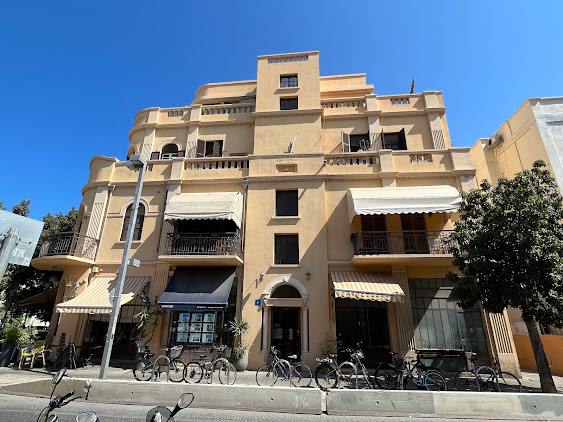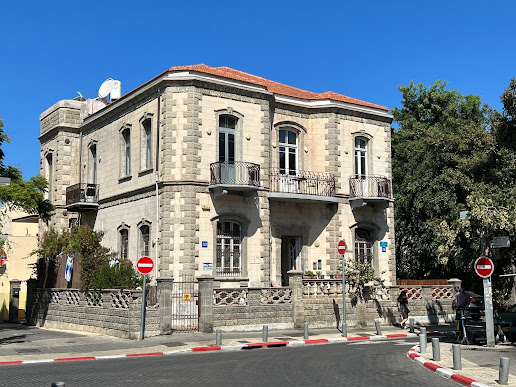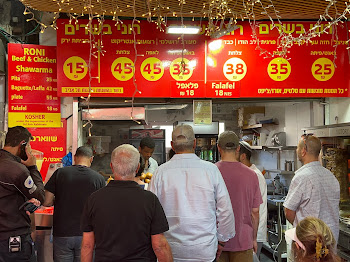Tel Aviv # 6, cont.
Hi, All -- Some of our friends asked what it takes make our blog. It's a lot of work! This is the sequence: Delete poor pictures from camera. Download good photos to the laptop. Photos are cropped/color corrected (if required). Next, there is a several-step process that "links" the Blog App to the photos. Once there is a connection, photos are selected and uploaded to the blog. The next step is to position the photos, add and size text. At the end of the process, we then "discuss" - add and/or delete. Each blog can take several hours. It's a lot of work but also fun! Thanks for your interest.
This is what "editing" our blog looks like.
We eat breakfast in this lovely patio and listen to the birds. This is a very quiet neighborhood. We're walking non-stop five to six miles each day. Lots of steps. We're wondering if all the of food we're eating will be minimized by the walking.
This is another manhole cover we found on our walk.
Old school no longer in use. Rather than tear down, the historical building has been converted into a multi-use facility for a famous Israeli dance troop, musical and meeting functions, etc.
Lots of art throughout the city
Sometimes we found art in the most unusual places. We stumbled upon this sculpture that was hidden behind an old, rusty gate in front of a home designated to be demolished. Who would know?
Israeli architecture is interesting: There's the historical (Jaffa) type buildings. Then, there are two basic 1900's designs: Eclectic and Bauhaus. Of course, today's designs are typically modern similar to what we might see in any major city.
Late 1800's style residence
Brand new: This was painted on a wall about a month ago.
This (eclectic) building (apartment or home) was expanded upward two times to meet the need of increasing population. Each generation building process has different window designs.
Bauhaus design originated in Germany - German approach was less rounded. Functionality was important at the time.
Two renovations. Three window styles. Notice the Hebrew. The original approach was to start making "things" Jewish throughout the country.
As part of the building design, the Star of David was added to (again) reinforce the concept of "Jewishness" and the concept of an Israeli state.
Fountain designed by Nahum Gutman
Without the guide, we would not have noticed the historical (Israeli) story incorporated into the mosaic designs. Representative details are below.
Slavery
Napoleon
1800's
1900's
Ben Gurion
Gymnasium is more than a school. Founders gave considerable thought about what is "Israel"- Language, urban growth, customs, military uniforms, etc. Reflection depicts historical events.
School building construction materials is encrusted with sea shells
Shalom Meir Tower has more Gutman mosaics
Theme deals with more current activities
Kibbutz Life
Shabbat dinner
Tel Aviv stock exchange
Eclectic and Bauhaus architecture side by side
Most stores, office buildings and historical homes have guards. Some guards are armed.
We returned to the Carmel Market
Spice scents permeated the area
Olives, olives and more olives
Dates and nuts
Fresh Almonds
The sandwich is made from a Turkish recipe. The owner is Jewish and the fish is supplied by an Arab. That's cooperation!!
Wrapping up the fish sandwich
This must be the best falafel place in Tel Aviv. Huge line to get the stuffed pita
Does anyone have a sweet tooth?
The baklava was unbelievably good

Druze food stand
Celery root
In order to enter Israel from Jordan (1979) - We had to cross over the Allenby Bridge - the "no man's land" that separated the two countries. Except for us, all of the (other) passengers were Arabs, chickens, ducks and a dog. The Israeli border guards thought we came from outer space. They couldn't understand why we were there and what we were doing.



















































No comments:
Post a Comment